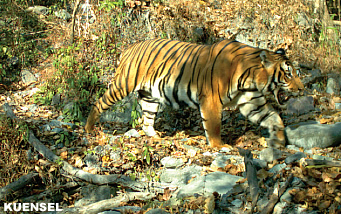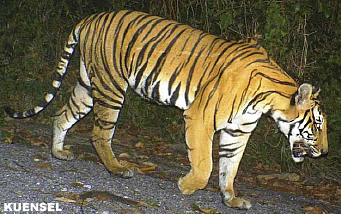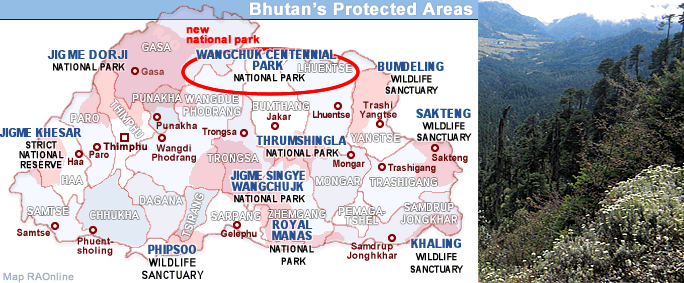| Bhutan's
Nature - Animals |
 |
Bhutan Nature Animals |
|
 |
Bhutan Information |
|
|
 |
| Royal Manas National Park |
 |
| Manas Trans-boundary: Wildlife conservation officials of Royal Manas National Park and Manas National Park in India have confirmed the presence of 14 Royal Bengal tigers across the trans-boundary area. Six out of that were tigresses.
This was seen as a significant development towards commitment by the 13 tiger range countries to double the number of tigers by 2020.
The estimated tiger population stands at 3,500 in the world today.
|
|
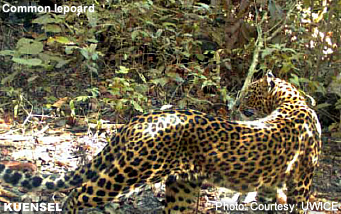 |
|
The Royal Manas National Park (RMNP) spread over 1057sqkm is located in the southern foothills and covers parts of Zhemgang, Sarpang and Pemagatshel.
It borders with India's Manas tiger reserve in the south forming a transboundary conservation landscape.
|
|
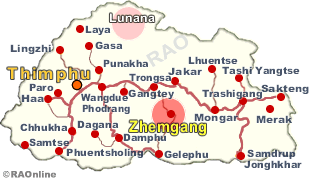 |
India's Manas National Park (MNP) covering some 500 sqkm is located in Baksa and Chirang districts of Bodoland territorial council in Assam.
Wildlife conservation officials said the two parks together formed the core of this extraordinary transboundary landscape, which is located at the junction of Indo-Gangetic and Indo-Malayan realms.
The Manas river, they said flowed through the two parks turning them into a large track of highly significant watershed area, home to one of the richest diversities of wildlife and vegetation found in the tropics.
In both national parks, conservationists said there was a combined record of 60 species of mammals such as Bengal tiger, clouded leopard, leopard, Asian elephant, Asiatic water buffalo, gaur and rhinoceros to name a few, besides, 500 species of birds such as white bellied heron and more than 1,000 plant species.
Royal Manas manager Tenzin Wangchuk said using 204 camera-traps worth USD 300 or so each, fixed in the core tiger habitat areas of royal Manas (74sqkm) and Manas national park (300sqkm), presence of a good number of breeding population for eight tigers and six tigresses were confirmed.
Tenzin Wangchuk was involved in the study carried out from November 2010 to February 2011. Cameras mounted on trees and poles were kept operational 24×7 for 64 days and to avoid damage by wild animals, mainly elephants, fresh elephant dung was placed on the cameras camouflaged to blend with surrounding environment.
"Of the 14 tigers, four were common, photographed both in RMNP and MNP," Tenzin Wangchuk said, adding each tiger photographed were carefully identified by their stripes on the flanks, limbs, forequarters and tail to avoid double counting.
"It was very expensive to cover all of RMNP and MNP areas," he said. "This joint study was possible only through financial, technical and field support from World Wildlife Fund and Bhutan Foundation."
WWF conservation director Vijay Moktan said to conserve wildlife population, all efforts were put in to strengthen connectivity between the two parks.
The joint study, first of its kind, used remote triggered camera traps and the capture-recapture framework to estimate the abundance and density of tigers in the Trans-boundary Manas Conservation Complex (TMCC).
Some 102 camera-trap pairs were used in three ranges to cover more than 400sqkm in the area.
|
The study report titled "Tigers across borders" released last week during the second Asian ministerial conference on tiger conservation in the capital states the unique landscape represented immense habitat diversity.
It ranged from tropical grasslands at 40-50m through subtropical forest at 300m to warm broad-leaved forest above 1,000m reaching up to 2,000m.
Conservation officials during the release said there were less than 3,500 tigers living in their natural habitat, scattered among the 13 tiger range countries occupying a mere seven percent of their historical range. |
|
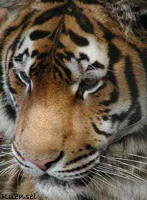 |
A failure to turn these trends, officials added, would result not only in the loss of tigers, but also bring about profound changes to ecosystem structures and dynamics throughout the tiger bearing regions.
TMCC, conservationists said was a transboundary landscape having unique biological significance.
It straddles the Indo-Bhutan border from the Ripu Reserve Forest in India in the west, to Bhutan's Khaling wildlife sanctuary in the east, and Jigme Singye Wangchuck National park in Bhutan to the north.
"TMCC encompasses the whole of India's Manas tiger reserve and the group of protected areas in southern Bhutan," royal Manas officials said, adding it was the only landscape in the world with eight species of cats - tiger, leopard, clouded leopard, marbled cat, golden cat, leopard cat, jungle cat and fishing cat - co-existing in the same area.
The study also photo-captured pictures of six other cats, five golden cats and a marbled cat as well as prey and other associated species.
Further camera traps also captured 27 leopards and 16 clouded leopards.
Park officials said conserving the prey population was crucial because prey population was the major factor in the decline of large carnivores including tigers.
"Tiger population can be increased through countering poaching activities and the RMNP have 95 forest officials to monitor the area," Tenzin Wangchuk said.
Challenges, he said was, however, mainly during monsoon season with heavy rains disturbing accessibility and without mobile connection in most parts.
"We hope to fix camera traps in other areas of the parks in future and get more information on tiger population and habitat," he said.
top
| Big cat territory |
 |
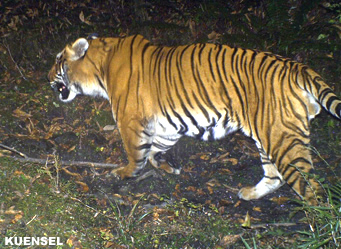 |
| For two nuns of the Thinleygang dratshang in Ngangla gewog, Zhemgang, their prayers were answered.The nuns, on the way to relieve themselves in the forest, encountered a leopard but no harm was done.
The incident happened at around five in the morning.The nuns, carrying only a torch, noticed small stones falling from the boulders near them.When they shone the torch up, an adult leopard jumped down from the boulder, glanced at them and continued downward. |
|
"We'd been hearing weird sounds at night for the past few months, which we believe was the leopard," the lam of the dratshang said. "We have nuns, who are five to 34 years old." The nuns are not the only ones in Ngangla gewog encountering wild cats.
Last month, in Marangdut village in the same gewog, a farmer lost his cow, only to find its limbs the next day in the forest nearby.The cow, forest officials confirmed, had been killed by a tiger that had come up from across the border of India's Manas tiger reserve.
"This is the second time, the first happened in 2008," the farmer said, over a telephone interview, adding that he didn't report it forest officials, since he did not get any compensation or protection for his animals. "For us, our livestock means everything," he said. "We see tigers roaming nearby our house at night and it's scary."
Several such cases were also reported in other villages under Ngangla gewog that consists of Sonamthang, Thinleygang, Rebati, Marangdut, Pongchaling, Ngangla Trong, Kaktong and Chutoe with 549 households.
Ngangla falls under the Royal Manas national park, located in the southern foothills of Bhutan, and borders with India's Manas tiger reserve.Manas is home to many endangered wildlife species, including leopard and tiger, forest officials said.
Other animals found are the Indian one-horned rhinoceros, elephant, Asiatic water buffalo, wild dog, golden langur, and critically endangered species like pigmy hog and hispid hare. Manas is also home to more than 350 species of birds.
Carnivores, other than tigers in Manas, are the common leopard, clouded leopard, jungle cats, Asiatic golden cat, leopard cat, marbled cat, large Indian civets, small Indian civets, Himalayan yellow throated martens, mongooses, otters, ferret badger and binturong.
"In most cases of human-wildlife conflict, where farmers lost their livestock, are mainly because of the tigers," a forest official said. "So far this year, we've confirmed through camera traps of two tigers that came from across the border," he said, adding that this is because of the prescribed periodic forest fire carried out in the Indian border areas.
Prescribed burning is a tool that can be very useful in management of natural areas, particularly native grass areas.It helps reduce invasive plant species, reduce potential fire hazards from accumulated dead or dry grass, and recycle valuable nutrients back into the soil where it will be used by new vegetation.
Some plant seeds only germinate after a hot fire, and fire-resistant roots allow them to sprout quickly, while using nutrients released during the fire forest, officials said.
Study by UWICE in Bumthang conclude that, in most places, tigers are wary of human beings and avoid encounters. The total tiger estimated through 27 camera traps in Royal Manas national park is 30-50 tigers.
 |
| Source: by Passang Norbu, KUENEL, Bhutan's National Newspaper 2012 |
top
| Wildlife and People in Bhutan |
 |
| Information on Bhutan |
 |
| Links |
 |
 |
 |
External
links |
|
|





